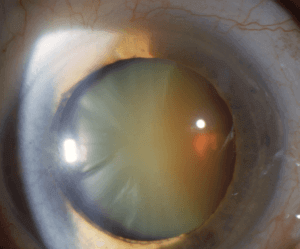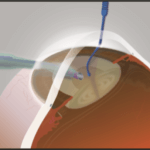Cataract surgery is one of the safest surgeries performed in the United States today and is most often done as an outpatient procedure. Most cataract procedures take only a short time and most patients recover quickly.
Call Us: 215-928-3180
Cataract surgery is one of the safest surgeries performed in the United States today and is most often done as an outpatient procedure. Most cataract procedures take only a short time and most patients recover quickly.
Call Us: 215-928-3180
 Cataract Removal and Lens Implantation
Cataract Removal and Lens ImplantationWhen cataract surgery is performed, most of the natural lens of the eye is removed but most of the capsule or membrane that surrounds the lens is left in place. This capsule helps to keep the fluids behind the lens undisturbed and also holds the intraocular lens (IOL).
What do I need to get ready for cataract surgery?
Your physician will examine your eyes to make sure that the cataract is the only reason for a change in your vision.Measurements are performed to determine the strength of the lens that will be placed inside your eye after removing the cataract. Based on your visual needs, you and your physician will decide together which power of lens (near, intermediate, or distance) would be best for you.
What are the steps of cataract surgery?
The surgery is performed in the operating room.
Phacoemulsification (a type of ultrasound) is the most common method used to remove the cataract. A local anesthesia (numbing gel) is placed in the eye and light intravenous sedation is administered by an anesthesiologist to keep you relaxed and calm during surgery. The eye is cleaned and the face will be covered with a sterile drape. You should not feel pain in your eye during surgery.
 An instrument opens the eyelids. Tiny incisions are made in the front of the eye to remove the cataract. An instrument is used to create an opening in the front part of your cataract and then melt and vacuum the cloudy lens.
An instrument opens the eyelids. Tiny incisions are made in the front of the eye to remove the cataract. An instrument is used to create an opening in the front part of your cataract and then melt and vacuum the cloudy lens.
 A small plastic lens will be placed in the eye. The incisions are closed, often without a stitch. The entire procedure takes about 30 minutes.
A small plastic lens will be placed in the eye. The incisions are closed, often without a stitch. The entire procedure takes about 30 minutes.
What should I expect after cataract surgery?
After surgery, your eye may be sore, and it may feel like there is something in it, like an eyelash. The drops may burn when you put them in, and your eye may water or tear a lot. These symptoms are common but usually are mild, and improve for most people after 1-2 days.Tylenol (acetaminophen) is a good option unless you are unable to take this medication. If your eye has severe pain or sudden worsening pain or vision after surgery, please call our office or on call physician immediately.
After surgery, you will be discharged with a clear plastic shield with or without a patch over the operated eye. An adult will need to drive you home since you will have received sedating medications.
Most patients will be asked to use a steroid and antibiotic eye drops to help reduce inflammation and prevent infections after surgery. It is particularly important to refrain from rubbing your eye until the eye is completely healed. Your doctor will provide you with further post-operative instructions. Usually you will be asked to return to the office the next day for a follow-up visit. Generally, patients can resume their normal activities after this post-operative visit.
Following cataract surgery, most of the healing occurs within three months. During that time, it is important to visit your ophthalmologist and use the eyedrops as prescribed. Depending on your job and your other eye, you should be able to return to work within a few days to a few weeks. Limitations in physical activities at work may be needed.
If you have had an intraocular lens implanted and have no complications, you will notice improved vision in a week, or even sooner. You can get temporary glasses shortly after the surgery, but your final eyeglass or contact lens will not be ordered until most of the healing is completed.
Will I have restrictions after surgery?
You will be given detailed instructions after your surgery that are specific to your eye’s needs. In general, the following guidelines apply:
There are no restrictions in reading, watching TV, using your phone, tablet device, computer, etc, but your eyes may tire more easily during these activities.
What are the possible risks of cataract surgery?
Cataract surgery has an excellent success rate. Still, all surgeries have risks, and your doctor will discuss general and individual risk factors with you before your surgery. We encourage you to discuss any questions you have with your surgeon.
Although it is not possible to develop another cataract in an eye that has already had cataract surgery, a “secondary cataract” may occur when patients develop a clouding of the capsule behind the IOL. This capsule helps to keep the fluids behind the lens undisturbed and also holds the IOL. If this capsule becomes clouded, the patient may experience a blurring of their vision. This clouding can occur months or even years after the original surgery and affects an estimated 20 percent of patients. The cloudiness can easily and painlessly be corrected by creating a small opening in the capsule. The procedure, called a Capsulotomy, is done using a YAG laser. It is performed on an out-patient basis and takes only a few minutes. Injections are not required.
